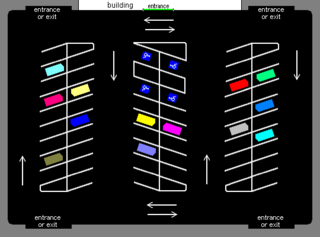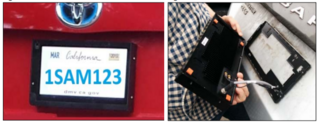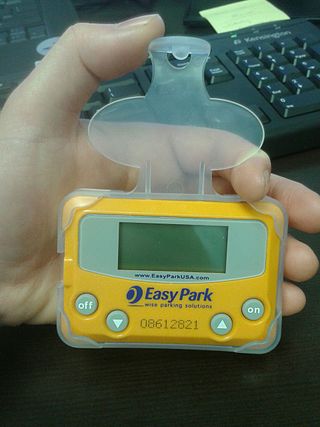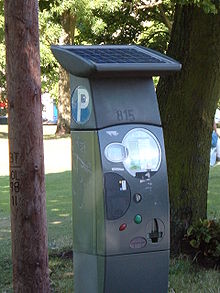
A smart card (SC), chip card, or integrated circuit card, is a card used to control access to a resource. It is typically a plastic credit card-sized card with an embedded integrated circuit (IC) chip. Many smart cards include a pattern of metal contacts to electrically connect to the internal chip. Others are contactless, and some are both. Smart cards can provide personal identification, authentication, data storage, and application processing. Applications include identification, financial, public transit, computer security, schools, and healthcare. Smart cards may provide strong security authentication for single sign-on (SSO) within organizations. Numerous nations have deployed smart cards throughout their populations.

A parking meter is a device used to collect money in exchange for the right to park a vehicle in a particular place for a limited amount of time. Parking meters can be used by municipalities as a tool for enforcing their integrated on-street parking policy, usually related to their traffic and mobility management policies, but are also used for revenue.

Electronic toll collection (ETC) is a wireless system to automatically collect the usage fee or toll charged to vehicles using toll roads, HOV lanes, toll bridges, and toll tunnels. It is a faster alternative which is replacing toll booths, where vehicles must stop and the driver manually pays the toll with cash or a card. In most systems, vehicles using the system are equipped with an automated radio transponder device. When the vehicle passes a roadside toll reader device, a radio signal from the reader triggers the transponder, which transmits back an identifying number which registers the vehicle's use of the road, and an electronic payment system charges the user the toll.

A parking lot or car park, also known as a car lot, is a cleared area intended for parking vehicles. The term usually refers to an area dedicated only for parking, with a durable or semi-durable surface. In most jurisdictions where cars are the dominant mode of transportation, parking lots are a major feature of cities and suburban areas. Shopping malls, sports stadiums, and other similar venues often have immense parking lots.

A pay and display machine is a type of ticket machine used for regulating parking in urban areas or in car parks. It relies on a customer purchasing a ticket from a machine and displaying the ticket on the dashboard, windscreen or passenger window of the vehicle. Details included on a printed ticket are generally the location and operator of the machine, expiry time, fee paid and time entered.

Automatic number-plate recognition is a technology that uses optical character recognition on images to read vehicle registration plates to create vehicle location data. It can use existing closed-circuit television, road-rule enforcement cameras, or cameras specifically designed for the task. ANPR is used by police forces around the world for law enforcement purposes, including checking if a vehicle is registered or licensed. It is also used for electronic toll collection on pay-per-use roads and as a method of cataloguing the movements of traffic, for example by highways agencies.
The American Association of Motor Vehicle Administrators (AAMVA) is a non-governmental, voluntary, tax-exempt, nonprofit educational association. AAMVA is a private corporation which strives to develop model programs in motor vehicle administration, police traffic services, and highway safety.

Open road tolling (ORT), also called all-electronic tolling, cashless tolling, or free-flow tolling, is the collection of tolls on toll roads without the use of toll booths. An electronic toll collection system is usually used instead. The major advantage to ORT is that users are able to drive through the toll plaza at highway speeds without having to slow down to pay the toll. In some installations, ORT may also reduce congestion at the plazas by allowing more vehicles per hour/per lane.
Muni Meter is the name used by the New York City Department of Transportation (NYCDOT) for its pay and display centralized parking meter system. The Muni Meter system was introduced broadly in 2009, following a period of experimentation that began in 1999. Muni Meters are located on streets adjacent to a group of parking spots, with no designated striping that separates spots. A driver parks their car, pays at the Muni Meter, and takes a receipt provided by the Meter. They then display that receipt on their vehicle's dashboard. The system reduces the number of individual meter devices required, increases the number of parking spots available and, some argue, reduces losses due to unused time left on meters.

A parking violation is the act of parking a motor vehicle in a restricted place or in an unauthorized manner. It is against the law virtually everywhere to park a vehicle in the middle of a highway or road; parking on one or both sides of a road, however, is commonly permitted. However, restrictions apply to such parking, and may result in an offense being committed. Such offenses are usually cited by a police officer or other government official in the form of a traffic ticket.

Video tolling is a form of electronic toll collection that uses video or still images of a vehicle's license plate to identify a vehicle liable to pay a road toll. The system dispenses with collection of road tolls using road-side cash or payment card methods, and may be used in conjunction with "all electronic" open road tolling, to permit drivers without an RFID device to use the toll road.
PrePass is an intelligent transportation system (ITS) that electronically verifies the safety, credentials, and weight of commercial vehicles as they approach participating state highway weigh stations. Because they comply electronically, commercial carriers enrolled in PrePass are authorized to bypass these facilities rather than pull in for manual inspection.

An electronic license plate is a vehicle-mounted identification device that emits a radio signal for tracking and digital monitoring purposes. Various patents have been published to replace traditional metal and plastic license plates. It communicates directly with a vehicle's computer system and other remote systems related to vehicle regulation.

Pay-by-phone parking is a system of paying for car parking via a mobile app or mobile network operator. It is an alternative to the traditional ways to pay for parking of parking meter or pay and display machines. SMS pay-by-phone parking was first introduced by Vipnet. Since its introduction in Croatian capital Zagreb in 2001 under the name M-parking, the number of registered users has steadily increased. By 2004, the Croatian M-parking scheme was the largest in Europe. Today, pay-by-phone parking is used by millions of people all around the world.

Lidar has a wide range of applications; one use is in traffic enforcement and in particular speed limit enforcement, has been gradually replacing radar since 2000. Current devices are designed to automate the entire process of speed detection, vehicle identification, driver identification and evidentiary documentation.
EUCARIS, an acronym for the European Car and Driving Licence Information System, is a collaborative initiative established in 1994 to combat international vehicle crime and driving license tourism through the exchange of vehicle and driving license information among its member nations. The primary aim of EUCARIS is to facilitate seamless information sharing, enabling member countries to conduct checks on potential obstacles for re-registration of vehicles or the exchange of driving licenses. This cooperative effort was formalized through the multilateral EUCARIS Treaty, which governs the activities of participating states in setting up and operating an information exchange system.

An in-vehicle parking meter(IVPM) (also known as in-vehicle personal meter, in-car parking meter, or personal parking meter) is a handheld electronic device, roughly the size of a pocket calculator, that drivers display in their car windows either as a parking permit or as proof of parking payment. IVPM was first implemented in the late 1980s in Arlington, VA, and is spreading to campuses and municipalities worldwide as a centralized method of parking management, revenue collection, and compliance enforcement.
The term digital card can refer to a physical item, such as a memory card on a camera, or, increasingly since 2017, to the digital content hosted as a virtual card or cloud card, as a digital virtual representation of a physical card. They share a common purpose: Identity Management, Credit card, Debit card or driver license. A non-physical digital card, unlike a Magnetic stripe card can emulate (imitate) any kind of card.
Flock Safety is an American manufacturer and operator of automated license plate recognition (ALPR), video surveillance, and gunfire locator systems. Founded in 2017, Flock operates such systems under contract with law enforcement agencies, neighborhood associations, and private businesses, and as of 2024, claims to operate in over 4,000 cities across 42 U.S. states.

Coin parking is a type of parking facility where users can park their vehicles in available spaces and pay based on the time they use. It is also called an hourly parking lot. The term "coin parking" was created in Japan, corresponding to "pay parking lots" in English.















